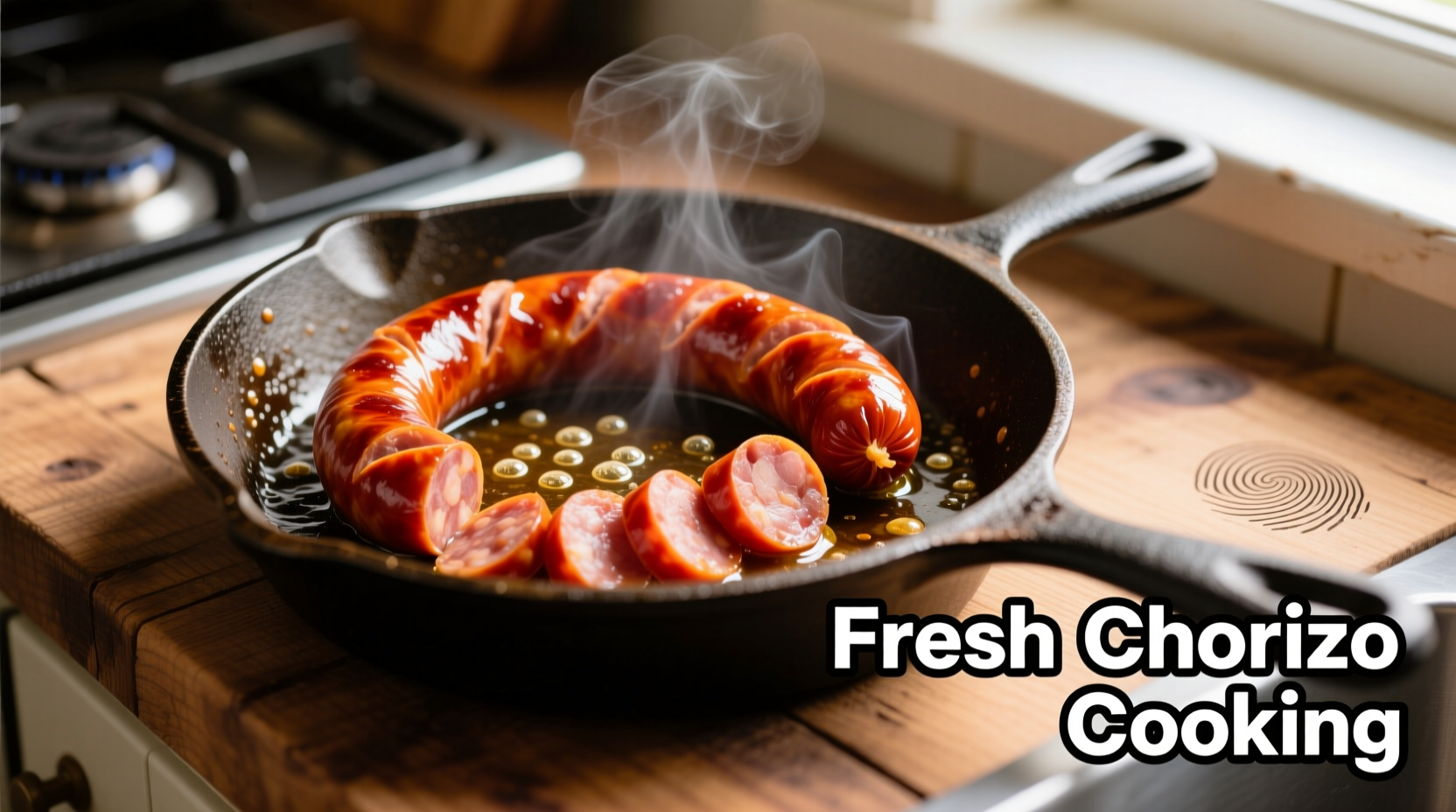Quick answer: Pan-fry fresh chorizo in a cold skillet over medium heat for 8-10 minutes, stirring occasionally, until fully cooked through and rendered fat turns clear. For cured chorizo, slice and sear for 2-3 minutes per side until edges crisp. Never cook fresh chorizo from frozen and always check internal temperature reaches 160°F (71°C) for safety.
Chorizo transforms from humble sausage to flavor powerhouse when cooked properly. Whether you're working with Spanish-style cured chorizo or Mexican fresh chorizo, the cooking method makes all the difference between rubbery disappointment and smoky perfection. As a Latin American cuisine specialist who's documented traditional preparation methods from Oaxaca to Buenos Aires, I've seen how improper cooking ruins this culturally significant ingredient.
Identify Your Chorizo Type First
Before touching a pan, determine which chorizo you're handling. This critical step prevents cooking disasters:
| Chorizo Type | Texture | Cooking Required | Common Regions |
|---|---|---|---|
| Spanish Cured | Firm, dry, sliceable | No cooking needed | Spain, Portugal |
| Mexican Fresh | Soft, raw sausage | Must be fully cooked | Mexico, Southwest US |
| Chorizo Verde | Green-hued, soft | Requires cooking | Oaxaca, Mexico |
According to USDA Food Safety guidelines, fresh chorizo must reach 160°F internal temperature to eliminate potential pathogens in pork products. Cured varieties contain preservatives making them safe to eat without cooking, though heating enhances flavor.
Essential Preparation Steps
Proper preparation prevents common mistakes that lead to burnt exteriors or raw interiors:
- Temperature check: Remove fresh chorizo from refrigerator 15 minutes before cooking
- No water rinse: Contrary to popular belief, never wash raw chorizo (USDA advises against washing raw meats)
- Cold pan start: Always begin with cold skillet for fresh chorizo to render fat properly
- Knife selection: Use serrated knife for cured varieties to prevent crumbling
Perfect Pan-Frying Technique (Most Common Method)
This method works for both fresh and cured chorizo, with slight variations:
- Place uncooked chorizo links or loose sausage in cold, dry skillet
- Set burner to medium heat (350°F/175°C surface temperature)
- For fresh chorizo: Cook 8-10 minutes, breaking into chunks with wooden spoon
- For cured chorizo: Sear 2-3 minutes per side until edges crisp
- Drain excess fat if desired, but reserve 1-2 tablespoons for cooking other ingredients
- Remove when internal temperature reaches 160°F (71°C) for fresh varieties
The rendering process follows a precise timeline: first 3 minutes produce cloudy white fat, next 4 minutes turn fat translucent, final minutes create golden cooking medium. Never increase heat to speed rendering - this causes casing rupture and uneven cooking.
Alternative Cooking Methods
Grilling for Smoky Flavor
Ideal for fresh chorizo links. Preheat grill to medium (375°F/190°C). Cook 10-12 minutes, turning every 3 minutes. Use indirect heat after first 6 minutes to prevent flare-ups. The USDA Meat and Poultry Hotline confirms grilled chorizo reaches safe temperatures when juices run clear with no pink remaining.
Baking for Hands-Off Cooking
Preheat oven to 375°F (190°C). Arrange chorizo on parchment-lined baking sheet. Bake fresh chorizo 15-18 minutes, cured slices 8-10 minutes. Stir halfway through cooking. This method produces evenly cooked results with minimal attention required.
Cooking in Liquid for Recipes
When adding to stews or braises, partially cook chorizo first to render fat, then add liquid. Simmer until internal temperature reaches 160°F (71°C). The National Center for Home Food Preservation notes this two-step method prevents greasy finished dishes while ensuring food safety.
How to Know When Chorizo Is Perfectly Cooked
Doneness indicators vary by type:
- Fresh chorizo: Transforms from soft pink to firm brown, fat renders clear, internal temperature 160°F
- Cured chorizo: Edges become crisp, oils release creating glossy surface, deepens in color
- Never: Leave pink interior in fresh chorizo or burn exterior before interior cooks
Food science explains why chorizo behaves differently than other sausages - the high paprika content lowers the smoke point of rendered fat. This creates a narrow temperature window between properly cooked and burnt.
Avoid These Common Mistakes
- Mistake: Starting with hot pan for fresh chorizo
Solution: Always cold pan start to properly render fat - Mistake: Overcrowding the pan
Solution: Cook in batches with space between pieces for even browning - Mistake: Discarding all rendered fat
Solution: Reserve 1-2 tablespoons to cook vegetables or eggs for flavor foundation
Safety and Storage Guidelines
Follow these food safety protocols from the USDA:
- Never cook fresh chorizo from frozen - thaw in refrigerator for 24 hours first
- Consume cooked chorizo within 3-4 days when refrigerated
- Freeze cooked chorizo for up to 3 months in airtight containers
- Discard if cooked chorizo develops sour smell or slimy texture
When incorporating cooked chorizo into other dishes, add it during the final 5-10 minutes of cooking to preserve its distinctive flavor compounds, which begin degrading at temperatures above 390°F (199°C).

Traditional Applications Across Regions
Understanding regional cooking contexts prevents cultural missteps:
- In Spain: Cured chorizo often added to bean stews during last 15 minutes of cooking
- In Mexico: Fresh chorizo typically cooked first to render fat for cooking eggs or potatoes
- In Portugal: Chorizo frequently grilled over vine cuttings for smoky flavor dimension
My field research across Latin America revealed that traditional cooks test chorizo doneness by pressing with a spoon - properly cooked sausage should spring back slightly while releasing clear fat droplets.











 浙公网安备
33010002000092号
浙公网安备
33010002000092号 浙B2-20120091-4
浙B2-20120091-4